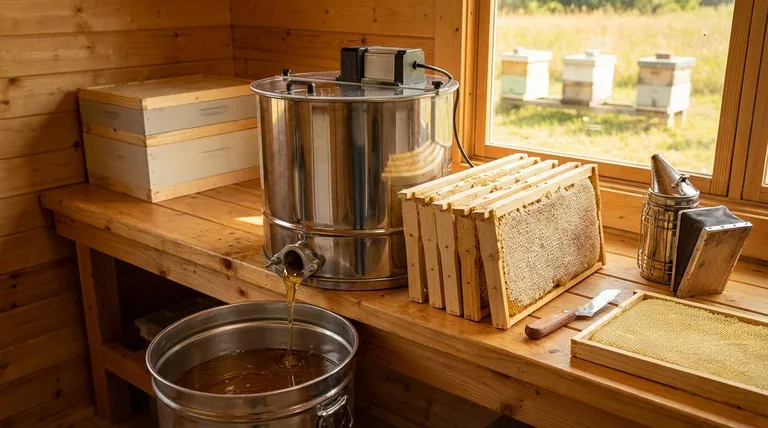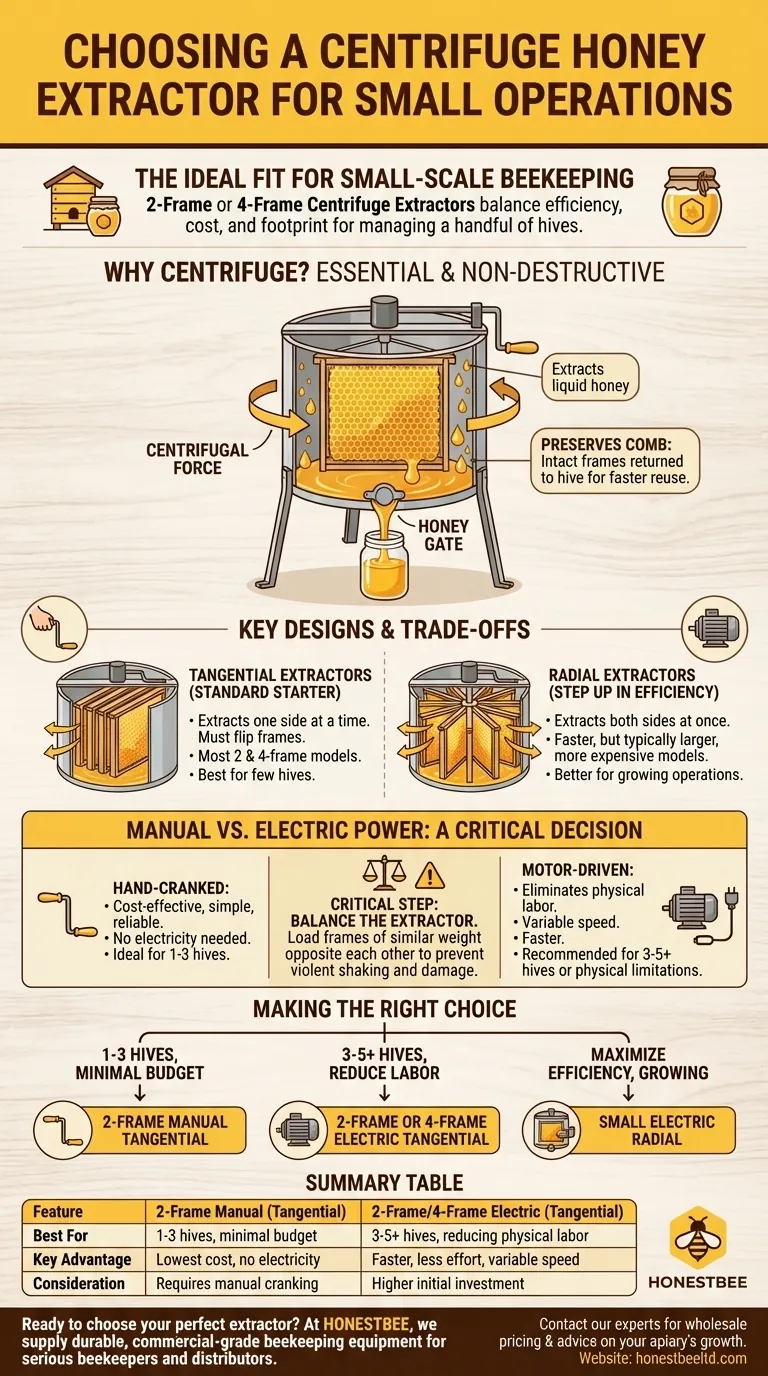For a small-scale beekeeping operation, the most suitable choice is typically a 2-frame or 4-frame centrifuge honey extractor. This size provides the perfect balance of efficiency, cost, and physical footprint for a beekeeper managing a handful of hives. It allows you to extract honey effectively without the significant investment required for larger, commercial-grade equipment.
Choosing your first honey extractor is a foundational investment in your beekeeping journey. While a small 2-frame model is the standard starting point, the critical decision lies in understanding the trade-offs between manual and electric power, as this will define your harvesting workflow.

Why a Centrifuge Extractor is Essential
A centrifuge is the standard for modern honey extraction because it is efficient and, most importantly, non-destructive. It allows you to harvest the honey while preserving the delicate beeswax comb your bees worked so hard to build.
The Principle of Centrifugal Force
An extractor works by spinning frames of honey in a drum. This spinning action generates centrifugal force, which flings the liquid honey out of the honeycomb cells and onto the inner wall of the drum. The honey then runs down the wall and collects at the bottom, where it can be drained through a valve, often called a honey gate.
The Benefit of Preserving Comb
The single greatest advantage of this method is that the honeycomb remains intact. After extraction, you can return the empty frames to the hive. This gives your bees a massive head start for the next season, as they can immediately begin refilling the comb rather than spending precious time and resources rebuilding it from scratch.
Key Extractor Designs for Small Operations
For small-scale use, you will primarily encounter tangential extractors. Understanding how they work is key to using them correctly.
Tangential Extractors: The Standard Starter
In a tangential extractor, the frames are placed with the comb surface facing outwards, parallel to the wall of the drum. This design only extracts honey from one side of the frame at a time.
You must spin the frames, flip them over, and then spin them again to empty both sides. Most 2-frame and 4-frame models are tangential and are highly effective for a small number of hives.
Radial Extractors: A Step Up in Efficiency
In a radial extractor, frames are loaded like spokes in a wheel, with the top bar of the frame facing outwards. Centrifugal force extracts honey from both sides of the frame simultaneously.
While significantly faster, radial designs are typically found in larger, more expensive models designed for beekeepers with many hives. For most beginners, a tangential model is more than sufficient.
Understanding the Trade-offs: Manual vs. Electric
Your most important decision will be whether to choose a hand-crank (manual) or motor-driven (electric) extractor.
The Case for Manual Extractors
A manual extractor is powered by a hand crank. It is the most cost-effective, simple, and reliable option, as there are no motors or electronics to fail. It requires no electricity, making it ideal for extracting honey in a shed or barn without power.
This is the perfect choice for a beekeeper with 1-3 hives, where the physical effort is minimal and the cost savings are significant.
The Case for Electric Extractors
An electric extractor uses a motor to spin the basket, often with variable speed control. It eliminates the physical labor of hand-cranking, which can become tiring after just a few frames.
If you manage more than 3 hives, anticipate growing your operation, or have physical limitations, the extra investment for an electric model will save you significant time and effort during the harvest.
Balancing the Extractor: A Critical Step
Regardless of the type, you must load frames of similar weight directly opposite each other. An unbalanced load will cause the extractor to shake violently and can damage the machine or your frames. Always balance your load for smooth operation.
Making the Right Choice for Your Operation
Choosing the right extractor is about aligning the equipment with the scale of your apiary and your budget.
- If your primary focus is keeping 1-3 hives with a minimal budget: A 2-frame manual tangential extractor is the most practical and economical choice.
- If your primary focus is managing 3-5+ hives or reducing physical labor: A 2-frame or 4-frame electric tangential extractor is a worthwhile investment that will save you considerable time.
- If your primary focus is maximizing efficiency as you grow: While a larger initial investment, a small electric radial extractor will dramatically speed up your harvest day.
Ultimately, selecting the right tool for the job ensures that you can enjoy the sweet rewards of your hard work efficiently and sustainably.
Summary Table:
| Feature | 2-Frame Manual (Tangential) | 2-Frame/4-Frame Electric (Tangential) |
|---|---|---|
| Best For | 1-3 hives, minimal budget | 3-5+ hives, reducing physical labor |
| Key Advantage | Lowest cost, no electricity needed | Faster, less effort, variable speed control |
| Consideration | Requires manual cranking | Higher initial investment |
Ready to choose the perfect extractor for your small operation?
At HONESTBEE, we supply durable, commercial-grade beekeeping equipment tailored for serious beekeepers and distributors. Whether you're starting with a 2-frame manual model or upgrading to an efficient electric extractor, we have the reliable tools to support your harvest.
Contact our experts today for wholesale pricing and advice on the best equipment for your apiary's growth.
Visual Guide

Related Products
- HONESTBEE 72 Frame Industrial Electric Honey Extractor for Beekeeping
- 8-Frame Electric Self-Reversing Honey Extractor Spinner for Commercial Honey Extraction Equipment
- Electric 8 Frame Honey Spinner Extractor Equipment for Beekeeping
- Commercial Electric 12 Frame Honey Extractor Spinner Motorized Honey Extractor
- 40 Frame Commercial Electric Honey Extractor for Beekeeping
People Also Ask
- What are the advantages of automated honey extractors in terms of time efficiency? Boost Your Harvest Speed
- Why do beekeepers have to lift a lot of weight at the end of a growing season? The Reward of a Heavy Harvest
- How do automatic honey extractors function? Achieve High-Efficiency Honey Harvesting
- What should a beekeeper do after extracting honey from supers? A Guide to Harvest Management
- Why is preserving honeycomb integrity important, and how do automated extractors help? Boost Hive Health & Honey Yields



















